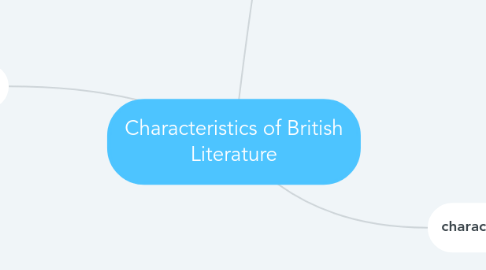
1. characteristics
1.1. The Romantic Period (1798-1832)-Writers looked for the beauty in nature and love and the ability of the individual to reach freedom by contemplating the natural world around him.
1.1.1. Human knowledge consists of impressions and ideas formed in the individual's mind
1.1.1.1. sentimental novels
1.1.1.1.1. Gothic fiction
1.1.1.1.2. poetry
1.2. The Victorian Period (1832-1901)-Industrialism ran wild; and since paper had become cheap, magazines and novels were mass produced. Literature reached the masses.
1.2.1. shocking life of sweatshops and urban poor is highlighted in literature to appeal for reform
1.2.1.1. Novel becomes popular for the first time because it is able to be mass produced
1.2.1.1.1. bildungsroman
1.2.1.1.2. political novels
1.2.1.1.3. detective novels (Sherlock Holmes)
1.2.1.1.4. serialized novels (Charles Dickens)
1.2.1.1.5. elegies
1.2.1.1.6. poetry (easier to understand, included dramatic monologues)
1.2.1.1.7. drama (comedies of manners)
1.2.1.1.8. magazines (stories to the masses)
1.3. The Modern Period (1901-1939ish)-Victoria was gone, Einstein undermined Newton's theories with his relativity, Freud was exposing the deepest inescapable human desires, and painters like Picasso were pulling the human form apart into geometric shapes.
1.3.1. a shared desire to break with established forms and subjects and reject realistic representation and formal expectations
1.3.1.1. novel - stream of consciousness and interior monologue
1.3.1.2. poetry - slang mixed with elevated language; free verse; difficult allusions and disconnected images
1.3.1.2.1. James Joyce
1.3.1.2.2. Virginia Woolf
1.3.1.2.3. W.B. Yeats
1.3.1.2.4. T.S. Eliot
1.4. Postmodernism (1940-2000s)-Postmodernism is both a continuation of the experimentation done by the Modernist writers (like fragmenting, paradox, questionable narrators)It's hard to define, but one can say that there was a little bit of everything in there.
1.4.1. novels - utopias and dystopias; political novels, and the power of the unconscious
1.4.1.1. drama - kitchen sink realism, drawing room plays, absurdism, radio plays
1.4.1.2. poetry - modernist poets were still publishing, but new poets tried to describe ordinary things in unfamiliar ways, like through the eyes of a Martian; also, concrete poetry (shape poems), performance poetry, and sound poetry
1.4.1.2.1. Orwell's 1984
1.4.1.2.2. Golding's Lord of the Flies
1.4.1.2.3. Anthony Burgess' A Clockwork Orange
1.4.1.2.4. Samuel Beckett's Waiting for Godot
2. Influences of British literature- heavily influenced by its Christian and Greco-Roman heritage
2.1. utopianism - the search for a perfect land in this life. Plato began the tradition in Ancient Greece, but Thomas Moore took over with the revolution with Utopia in the 1600's
3. characteristics
3.1. Old English/Anglo-Saxon Period (449-1066)-Christianity helped literacy to spread and the Roman alphabet was introduced to Britain, and the oral tradition helped unite diverse peoples and their myths.
3.1.1. religious faith and moral instruction given through literature
3.1.1.1. oral tradition in literature
3.1.1.1.1. poetry dominant genre
3.1.1.1.2. unique verse form that included caesura, alliteration, repetition and four-beat rhythm.
3.2. The Middle English Period (Medieval Period) (1066-1485)-A large percentage of the population was illiterate, so much of literature was focused on the church instructing its members through morality and miracle plays
3.2.1. Plays that instruct the illiterate masses in morals and religion
3.2.1.1. oral tradition continutes
3.2.1.1.1. folk ballads
3.2.1.1.2. mystery and miracle plays
3.2.1.1.3. morality plays
3.2.1.1.4. stock epithets
3.2.1.1.5. kennings
3.2.1.1.6. frame stories
3.2.1.1.7. moral tales
3.3. The Renaissance (1485-1660)- It began when the War of the Roses ended in 1485 and England enjoyed political stability. The printing press helped stabilize the English language and allowed more people to read.
3.3.1. World view shifts from religion to human life on earth Themes included human potential and love: unrequited, constant, timely, courtly, and changing love
3.3.1.1. Poetry - sonnets and metaphysical poetry full of elaborate and unexpected metaphors called conceits
3.3.1.2. Drama - usually written in verse, supported by royalty, and made up primarily of tragedies, comedies, and histories
3.3.1.2.1. Shakespeare
3.3.1.2.2. Ben Jonson
3.3.1.2.3. John Donne
3.3.1.2.4. Christopher Marlowe
3.3.1.2.5. Andrew Marvell
3.3.1.2.6. Robert Herrick
3.3.1.2.7. Katherine Phillips
3.4. The Neoclassical Period (1660-1798)-dramatic rise in literacy - about 50% of males are functionally literate. Literature continued to focus on the individual, but brought in the belief that humanity is basically evil. Writers began to imagine "the world as it should be."
3.4.1. John Locke teaches that a social contract exists between the government and the people. The government should guarantee the "natural rights" of life, liberty, and property.
3.4.1.1. satire
3.4.1.1.1. poetry
3.4.1.1.2. essays
3.4.1.1.3. letters, diaries, biographies
3.4.1.1.4. novels

